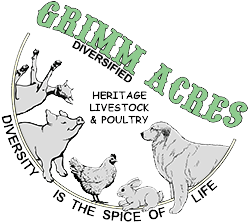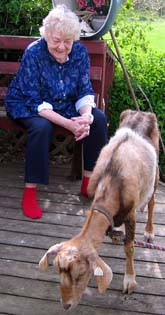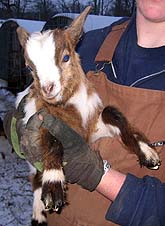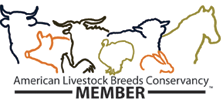Heritage Poultry raised at Grimm Acres
About Chickens and Grandma Smith’s Sunday table.
Currently we are raising Buckeyes, Russian Orloffs, Blue Cochins and Dorkings.
The Heritage Poultry we have chosen to raise at Grimm Acres were selected from the American Livestock Breeds Conservancy’s (ALBC) list of poultry breeds needing our support to avoid being lost altogether. We looked at each of the chicken breeds individually, and tried several of them in small numbers. We looked for breeds that were dual purpose, well suited to our Southern Illinois climate, especially our winters. We also wanted birds with the right “personality” for our little farm.
We encourage visitors and only have animals that display a calm temperament and are not prone to any aggressive behaviors.
Another factor we were looking for was, of course, ‘Diversity’. Each of our current breeds looks distinctly different, and serves a different purpose here on the farm.
Buckeyes
We have chosen the Buckeyes as our primary egg layers. The hens lay approximately 200 medium to large brown eggs each year. We have found them to be good consistent layers, even in the winter. Hen weigh around 6 ½ pounds and roosters will weigh about 9 pounds. They are excellent butchering chickens with dark and flavorful meat. Buckeyes also have the distinction of being the only breed developed entirely by a woman, Mrs. Nettie Metcalf of Warren, Ohio. Their beautiful mahogany color reminds us of polished buckeyes, and explains their name.
Active foragers, these chickens are aggressive mousers who can put many barn cats to shame. Their pea comb helps them handle the cold, and we have had no problems over-wintering our buckeyes in our hoop house system. ALBC currently lists them as “critical”.
Russian Orloffs
Another bird on the ALBC “critical” list, the Russian Orloff is a tall, beautiful bird with a thickly feathered neck and a “cushion” or rose comb. These chickens are extremely cold hardy and have a calm, friendly manor that we find especially endearing. Ours often come into the back yard and peer through the French doors of the house as if to see what we’re up to. They lay a medium size light brown egg, and are extremely flavorful when processed, although we prefer them roasted, steamed or stewed.
Red Dorking
Dorking chickens are a very old breed originating as we know it today in England, although a five toed chicken that sounds very much like the Dorking was mentioned in some Roman literature. In the early 1900’s Dorkings were the most popular chicken breed in England. These are really good table birds with rick flavor and tender meat even when butchered as adult roosters. The hens lay well, even in the winter. Males can weigh as much as 9 pounds and we are working on breeding for size and breed standard conformation.
Blue Cochin
Cochins are large, calm chickens with “an abundance of feathers”. We got our first Cochin hens as a gift, and fell in love with the way they look. These, more than any other breed look like the story book hens from my childhood. Their gentle personality makes them easy to tame and just that much easier to love!
The Cochin’s brown eggs are large and these chickens lay well during the winter months when some other breeds are laying few if any eggs.
According to TLC, “Cochin hens are inclined to broodiness and will hatch more than one batch per year if allowed” and we have found that to be true with our hens.
What makes a chicken a Heritage Breed?
The ALBC defines Heritage Poultry in their “Abbreviated Definition” this way: “A Heritage Egg can only be produced by an American Poultry Association Standard breed. A Heritage Chicken is hatched
from a heritage egg sired by an American Poultry Association Standard breed established prior to the mid-20th century, is slow growing, naturally mated with a long productive outdoor life.” (*see the full definition including the endorsers at the bottom of the page.)
Why are we, and why should you, be concerned with the genetic diversity of these chickens?
Most of these breeds are literally in danger of becoming extinct. Once lost, the unique characteristics of those genes, which have evolved over time to help these fowl adapt to different climates, resist diseases and parasites, and survive threats that we have yet to even identify will be lost to us forever.
The long-term survival of any species is impacted by the diversity of the genetic material available to that species. Think about in-breeding risks, and the many problems with reestablishing any species of life when only a few of those birds/animals are available to reproduce.
And our domestic food system is put at risk when we limit the genetic diversity of any component of that system. We can turn to history and be reminded of that risk.
- In 1970, US farmers lost $1 billion worth of crops after a disease killed uniform corn varieties.
Science 19 March 1971:
Vol. 171 no. 3976 pp. 1113-1116
DOI: 10.1126/science.171.3976.1113
The Southern Corn Leaf Blight Epidemic
L. A. Tatum - Lack of genetic diversity led to massive outbreaks of citrus canker in Florida in 1984 and in Brazil in 1991.
Science News: Destructive Citrus Disease Affecting Florida Could Be Combated With Bacteria-Resistant Trees, Early Detection ScienceDaily (Mar. 23, 2010)--- http://www.sciencedaily.com/releases/2010/03/100323105956.htm - During the 1840's, the majority of the population of Ireland relied upon a single variety of
the potato. As a result of the lack of genetic diversity, a fungus was able to destroy the entire
potato crop, causing the infamous Irish Potato Famine.
Pollan, Michael (2001)
The Botany of Desire: A Plant's-Eye View of the World.
New York: Random House. ISBN 9780375501296. Page 226
The Economic Research Service of the USDA (United States Department of Agriculture) has a thoughtful and interesting booklet on the role of biodiversity in both plants and animals in American agriculture. The Agricultural Outlook/December 1996 defines biodiversity and explores it economic impact on agriculture in the US and beyond.
It is our desire here at Grimm Acres to promote the utilization of these Heritage breeds in order to ensure that we continue to have access to their genetic diversity, their unique beauty, their amazingly varied personalities and the connection to our common history that they bring to us today. We want our children’s children, and your children’s children, to laugh at the antics of these complex and amazing birds, and to taste real chicken the way it tasted on my Grandma Smith’s Sunday table.
Heritage Chicken must adhere to all the following:
1. APA Standard Breed. Heritage Chicken must be from parent and grandparent stock of breeds recognized by the American Poultry Association (APA) prior to the mid-20th century; whose genetic line can be traced back multiple generations; and with traits that meet the APA Standard of Perfection guidelines for the breed. Heritage Chicken must be produced and sired by an APA Standard breed. Heritage eggs must be laid by an APA Standard breed.
2. Naturally mating. Heritage Chicken must be reproduced and genetically maintained through natural mating. Chickens marketed as Heritage must be the result of naturally mating pairs of both grandparent and parent stock.
3. Long, productive outdoor lifespan. Heritage Chicken must have the genetic ability to live a long, vigorous life and thrive in the rigors of pasture-based, outdoor production systems. Breeding hens should be productive for 5-7 years and roosters for 3-5 years.
4. Slow growth rate. Heritage Chicken must have a moderate to slow rate of growth, reaching appropriate market weight for the breed in no less than 16 weeks. This gives the chicken time to develop strong skeletal structure and healthy organs prior to building muscle mass. Chickens marketed as Heritage must include the variety and breed name on the label. Terms like “heirloom,” “antique,” “old-fashioned,” and “old timey” imply Heritage and are understood to be synonymous with the definition provided here.
The Livestock Conservancy
Over 30 years of experience, knowledge, and understanding of endangered breeds, genetic conservation, and breeder networks.
Endorsed by the following individuals
Frank Reese, Reese Turkeys, Good Shepherd Turkey Ranch, Standard Bred Poultry Institute, and American Poultry Association;
Marjorie Bender, Research & Technical Program Director, American Livestock Breeds Conservancy;
D. Phillip Sponenberg, DVM, PhD., Technical Advisor, American Livestock Breeds Conservancy, and Professor, Veterinary Pathology and Genetics, Virginia Tech;
Don Bixby, DVM, Independent Consultant, former Executive Director for the American Livestock Breeds Conservancy;
R. Scott Beyer, PhD, Associate Professor, Poultry Nutrition Management, Kansas State University;
Danny Williamson, Windmill Farm, Good Shepherd Turkey Ranch, and American Poultry Association;
Anne Fanatico, PhD, Research Associate, Center of Excellence for Poultry Science, University of Arkansas;
Kenneth E. Anderson, Professor, Poultry Extension Specialist, North Carolina State University.
To learn more information about Heritage Chicken breeds, go to www.heritagechicken.org.



